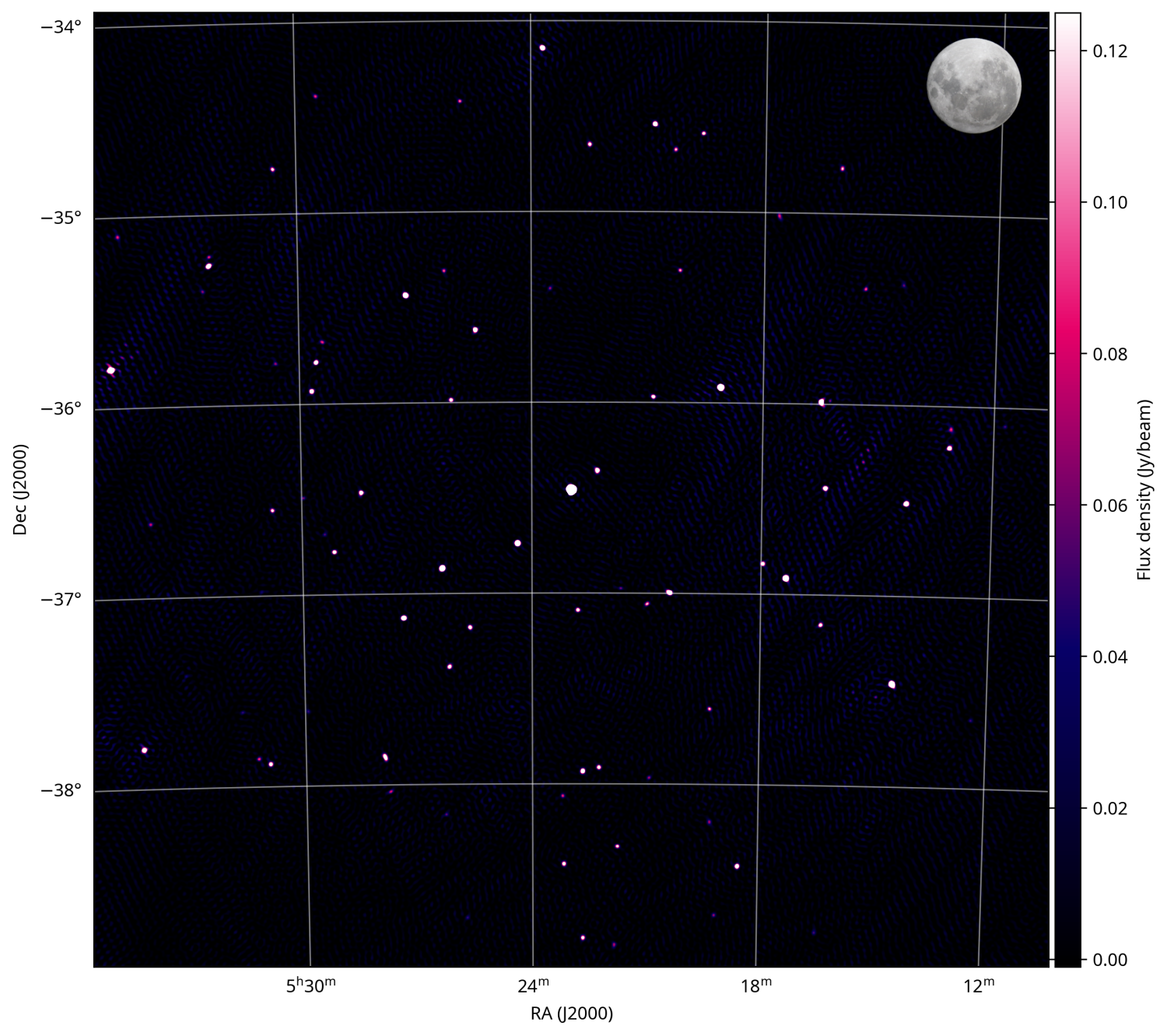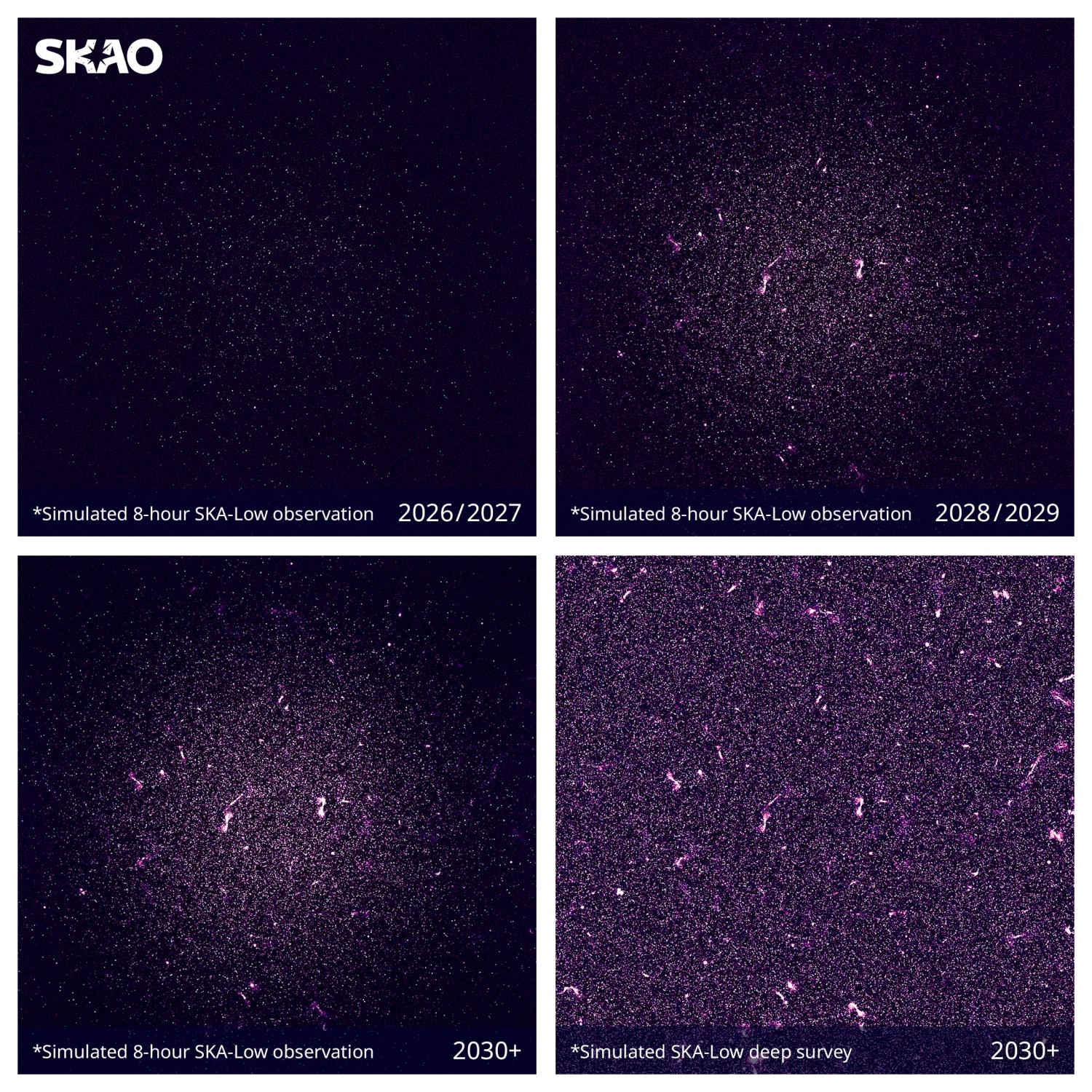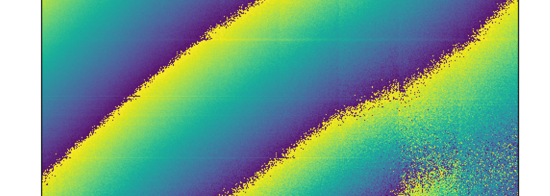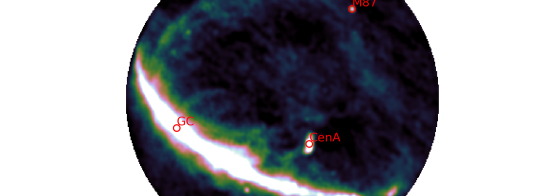'Beyond what we'd hoped': SKA-Low's first glimpse of the Universe
It is the first image from an early working version of the SKA-Low telescope, using just 1,024 of the planned 131,072 antennas, and an exciting indication of the scientific revelations that will be possible with the world’s most powerful radio observatory. SKA-Low is one of two telescopes under construction by the SKA Observatory (SKAO), co-hosted in Australia and South Africa on behalf of its member states and the global community.
The image shows an area of sky of about 25 square degrees – equivalent to approximately 100 full Moons. In it we see around 85 of the brightest known galaxies in that region, all of which contain supermassive black holes. When complete, the same area of sky will reveal much more – scientists calculate the telescope will be sensitive enough to show more than 600,000 galaxies in the same frame.

The first image from an early working version of the SKA Observatory’s SKA-Low telescope, which is currently under construction on Wajarri Yamaji Country in Western Australia. The dots in the image look like stars but are in fact some of the brightest galaxies in the Universe, seen in radio light. These galaxies are billions of light years away and each contains a supermassive black hole. Gas orbiting around black holes is very hot and moves quickly, emitting energy in X-rays and radio waves. SKA-Low can detect these radio waves that have travelled billions of light years across the Universe to reach Earth. At the centre of the image is one of only a handful of galaxies known to expel jets of matter that are visible in both optical and radio light.
The image was produced using data collected from the first four connected SKA-Low stations, which together comprise the first 1,024 of SKA-Low’s two-metre-tall metal antennas. They were installed over the past year at Inyarrimanha Ilgari Bundara, the CSIRO Murchison Radio-astronomy Observatory on Wajarri Yamaji Country, and account for less than one percent of the full telescope.
SKA-Low Lead Commissioning Scientist Dr George Heald said he was delighted to see how well the first four stations were working together.
“The quality of this image was even beyond what we hoped for using such an early version of the telescope,” Dr Heald said.
“The bright galaxies we can see in this image are just the tip of iceberg. With the full telescope we will have the sensitivity to reveal the faintest and most distant galaxies, back to the early Universe when the first stars and galaxies started to form. This is technically difficult work and the first step to unlocking the awesome science that will be possible.”
SKA-Low Telescope Director Dr Sarah Pearce said the team had achieved stellar results.
“This is the culmination of effort from many talented and committed people across teams, organisations and continents,” Dr Pearce said.
“Getting to this point has taken engineers, astronomers and computer scientists from all over the world, working for decades. It’s amazing to see all this work come together to give our first glimpse of the brilliant images that will come from SKA-Low, promising us a view of the Universe we’ve never seen before.”
The animation shows the various stages of delivery of the SKA-Low telescope over the coming years, and the images it is expected to be able to produce of the same area of the sky. The 1,024 antennas used to produce today’s image represent less than 1% of the full telescope and are spread over a distance of less than 6 km. They revealed 85 galaxies in an area of the sky equivalent to 100 full moons over a 7-hour observation. By 2026/2027, another 16,000 antennas will make SKA-Low the most sensitive radio telescope of its kind in the world and enable it to detect over 4,500 galaxies in the same area of the sky. By 2028/2029, SKA-Low will count over 78,000 antennas and be able to detect more than 23,000 galaxies in this field. The full SKA-Low telescope will count more than 130,000 antennas and spread over 74 km. Deep surveys performed of this area of the sky from 2030 will be able to reveal up to 600,000 galaxies.
The SKA telescopes – SKA-Low in remote Western Australia and its counterpart SKA-Mid in South Africa’s Northern Cape – are arrays that combine the data captured by individual antennas spread over large distances, working together as one big telescope.
SKAO Director-General Prof. Philip Diamond said the image illustrated the dawn of the Observatory as a science facility.
“With this image we see the promise of the SKA Observatory as it opens its eyes to the Universe,” Prof. Diamond said.
“This first image is a critical step for the Observatory, and for the astronomy community; we are demonstrating that the system as a whole is working. As the telescopes grow, and more stations and dishes come online, we’ll see the images improve in leaps and bounds and start to realise the full power of the SKAO.”
The SKA telescopes are being constructed in stages, with components coming from SKAO member countries around the world.
In Australia, SKA-Low is being built in collaboration with Australia’s national science agency, CSIRO. It will scale significantly to become the world’s largest low-frequency radio telescope within the next two years, part way through construction.
The observatory site has been established with the support of the Australian and Western Australian governments.
The SKAO recognises and acknowledges the Indigenous peoples and cultures that have traditionally lived on the lands on which our facilities are located. The data was obtained at Inyarrimanha Ilgari Bundara, the CSIRO Murchison Radio-astronomy Observatory. The SKAO and CSIRO acknowledge the Wajarri Yamaji as the Traditional Owners and Native Title Holders of the observatory site.
Supporting statement
Jamie Strickland, CEO, Wajarri Yamaji Aboriginal Corporation:
“Wajarri Yamaji People have been studying the sky and stars across Wajarri barna (land) for countless generations. It is fantastic to see the next leap in astronomy knowledge starting to take shape from our barna, and we’re proud to be partnering with the SKAO, the Australian Government and CSIRO to help make this a reality. Using today’s technology to help tell the stories of the past and also help understand the stories of the future.”
Media
Australian media contact
Sebastian Neuweiler
+61 437 976 806
Sebastian.Neuweiler@skao.int
Global media contact
Cassandra Cavallaro
+44 738 4511 285
Cassandra.Cavallaro@skao.int
You’ll find high resolution images, simulations of SKA-Low's future capability, and other video material in our media kit.

About the SKAO
The SKAO is an intergovernmental organisation composed of Member States and partner organisations from five continents, headquartered in the UK. Its mission is to build and operate cutting-edge radio telescopes to transform our understanding of the Universe and deliver benefits to society through global collaboration and innovation.
Its two telescopes, under construction in Australia and South Africa, will be the two most advanced radio telescopes on Earth. Together with other state-of-the-art research facilities, the SKAO’s telescopes will explore the unknown frontiers of science and deepen our understanding of key processes, including the formation and evolution of galaxies, fundamental physics in extreme environments and the origins of life.
Through the development of innovative technologies and its contribution to addressing societal challenges, the SKAO will play its part to address the United Nations’ Sustainable Development Goals and deliver significant benefits across its membership and beyond. The SKAO recognises and acknowledges the Indigenous peoples and cultures that have traditionally lived on the lands on which the SKAO facilities are located.







